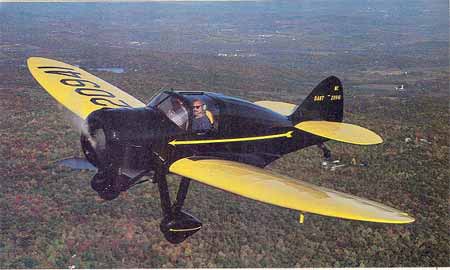There is just no other way to describe it: “Cute” is the
perfect adjective. I said that when I saw Dave Foulke coming down final
and slow to a near stop before depositing his black and yellow Dart
in the grass of Aeroflex field. Ashe taxied up, all the local tire-kickers
said, almost inunison, “Damn, that thing’s cute.” When
Harry Shepard climbed out of it after flying a photo mission, even
he allowed as how "cute" was the right description.
There is something about the way the Dart is put together that
looks much more like a model air-plane from an earlier age than an
airplane that missed being a Monocoupe by nothing but a twist of fate.
It could be the highly dihedraled wings that make the machine look
like a rubber-powered scale model. Or perhaps it's the blunt elliptical
planform of the wings which, from certain angles, lend a definite bumblebee
appearance. Or maybe it's the tiny round engine that snuggles under
the exquisite bumped cowl that appears to have shrunk several
sizes over the years. Undoubtedly, all these things are stirred together
by the mind's eye and become something sweet for our mind to taste.
But it's something other than beautiful. This plane is way past neat
and not quite funky. Simply, the thing's damned cute.
 |
The wood wings use big box
section spars. At least one Dart was clipped and used extensively
for airshow aerobatics. |
When Al Mooney (yes, that Al Mooney) first laid down
the lines for the Dart in the late 1930s, he was working for Monocoupe
and "cute" wasn't
part of the equation. The little low-winged machine he was designing
as Monocoupe's departure from their traditional high-wing theme was
to be a trainer. It was to offer a low-cost and easy-to-fly airplane
for the masses who, at that point in the Depression, were probably
more interested in where the next meal was coming from than learning
to fly. Under the Monocoupe scheme-of-things, the design was to be
offered in two flavors: the MonoPrep and the MonoSport. The primary
difference between them was one had an open cockpit and
the other used upward sliding plexi-doors that kept your date from
getting her brains blown out.
The public disclosure of the machine in a 1936 Flying magazine announced
it powered by the 90 hp Lambert Radial and proclaimed the plane as
the trainer for the future. But its future was not to be as a Monocoupe.
Knight Culver stepped in and made Claire Bunche and Monocoupe an offer
they couldn't refuse. He walked away not only with the design of what
was to be called the Dart, but a flying prototype and a living, breathing
designer (Al Mooney) as part of the bargain. Culver set up shop in
the old Lane Aviation hangars on Columbus Airport, which are still
standing to this day and are still operated by Lane Aviation.
The four or five airframes originally built by Monocoupe were finished
and assembled by the new company, Dart Manufacturing, as the Model
G with the 90 hp Lambert; the GK with the Ken Royce; the GW with the
90 hp Warner; all of them being tiny radials that would look good hanging
on any den wall. Unfortunately, the Dart could use a little extra power
so, just prior to World War Two, they fitted a mystery Continental
engine called the A-100, which appears to be the 100 horse predecessor
of the six cylinder A-125 as used in so many Swifts. It's a mystery
engine because even Continental has never heard of it and the engine
appears to have never been used in any airplane other than a few Darts.
Sometime during the war, Culver sold the design and manufacturing rights
to Ray Applegate and Romer Weyant, who began to manufacture the airplane
shortly after the war with the A-100 engine only. They also designed
and built parts for a little retract version of the Dart, but it never
was produced. In fact, Applegate, Weyant Engineering only produced
something like a dozen airplanes after the war before they tossed in
the towel.
All this information is totally superfluous, unless you enjoy bits
and pieces of history as so many of us do; like remembering the Model
I Dart with the 165 hp Warner and the clipped wings, or Rod Jocelyn
and his 220 Continental clipped wing Dart that looked like a Gee Bee
as much as anything else. The important thing is that there are still
a number of these airplanes floating around. According to Lloyd Washburn,
who's recognized as the nation's Dart maven, there are some-thing in
the neighborhood of twenty-eight airframes in existence, but only seven
of them are flying, which means there are twenty-one additional airplanes
that would easily fit in your garage and keep you busy for a winter
or two.
GO TO NEXT PAGE
|

